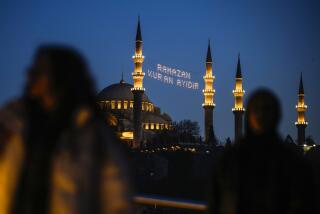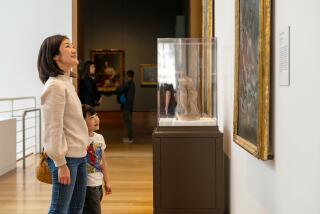At Bowers Museum, ‘Gods and Gifts’ samples a Vatican collection
“Gods and Gifts: Vatican Ethnological Collection,” at the Bowers Museum in Santa Ana, may cover more ground than any exhibition seen in Southern California: Its 70-plus artifacts span 2 million years and hail from all six inhabited continents, plus Polynesia, Easter Island and other Pacific locales.
According to Merriam Webster, “catholic” means “comprehensive … broad in sympathies, tastes or interests.” That’s the sensibility on view at the Bowers through Feb. 9. Objects of worship and religious instruction dominate “Gods and Gifts,” but only a handful are Christian.
In fact, the Christian artifacts are among the humblest on display, although perhaps the very humblest, a tiny earthenware oil lamp with a cross for a handle, may be deeply stirring to Christians because it’s from the faith’s dawning in ancient Palestine. A brass crucifix wrought in the Congo in the late 1600s features a likeness of Jesus.
CRITICS’ PICKS: What to watch, where to go, what to eat
The “wow” factor in this show comes from other religions, including Buddhism and Hinduism, and from a range of traditions of native peoples from around the world. You’d be hard-pressed to find a word from the Gospels, but readers of Arabic can parse Koranic scriptures emblazoned on vessels from an Islamic region of China.
“Who would ever dream the Vatican would be collecting cultures and religions of the world?” Bowers President Peter Keller asked after leading a tour of the show with Father Nicola Mapelli, director of the Vatican Ethnological Museum.
And who would dream that a display owned and provided by the Church would include a painted image of the blue-headed Hindu god Vishnu (or, more precisely, one of his many avatars) fondling the ample breasts of a happy consort? Or a small statue of Dionysus, the ancient Roman god whose devotees expressed their faith by indulging in orgies?
The first object greeting visitors to “Gods and Gifts” will sorely disappoint creationists. It’s a chipped rock the size and color of a small potato. At 2 million years old, it’s said to be the earliest type of implement fashioned by hominids (according to the website catholic.com, the Church has no position on evolution, other than that humanity has developed according to a divine plan).
CHEAT SHEET: Fall arts preview
“Is it human or not human?” Mapelli asked of the object’s maker, leaving the question open. “We say it’s the first intentionally shaped tool.”
The Vatican Ethnological Museum had its genesis in 1925, in what was known as the Universal Missionary Exhibition. Catholic missions from around the world sent some 100,000 artifacts to the Vatican for a display overseen by Wilhelm Schmidt, an ethnologist and priest. They were gifts, not loans, and from them the museum was born.
According to the museum’s official history, Schmidt believed that God had transmitted primordial religious truths to all human cultures, but that material progress was spiritually deadening. By the 20th century tribal groups had become “the true custodians of a message that the rest of humanity had lost,” and the museum aimed to preserve it.
Mapelli said another intention at the time was to combat theories about master and inferior races that were then rampant in Europe, soon to have the direst consequences.
The message in 1925, he said, was that all the world’s peoples deserved respect, because they all created striking art. While Schmidt’s spiritual theories no longer guide the museum, Mapelli said the broader intent remains: “It’s a reciprocal approach, to create a world of peace and understanding and harmony” by appreciating artworks from a panoply of cultures and beliefs.
ART: Can you guess the high price?
The Vatican Ethnological Museum was closed for decades until 2010, when it reopened with a permanent exhibition of aboriginal artifacts from Australia. Mapelli said it will gradually roll out other areas of the collection in coming years.
Meanwhile, a new phase of its mission is to mount exhibitions around the world, starting with “Objects of Belief From the Vatican,” a display of fewer than 40 objects from the Vatican that recently closed at the DeYoung Museum in San Francisco after a seven-month run. Keller said that he and other Bowers leaders liked the DeYoung show so much that they decided to bring it to Santa Ana — only doubled.
Among many impressive attractions are an illustrated scroll from 1600s China that’s a pictorial map of the Great Wall. A set of eight Japanese scrolls dated 1289 make up a complete Buddhist Lotus Sutra, written in gold on indigo-dyed paper, with the Buddha and eight of his disciples sporting halos on the front panel.
The aforementioned amorous Hindu god is one of more than 25 paintings surrounding a carved deity enshrined in a table-top sized wooden “Portable Temple of Vishnu” created in India during the 1700s.
The newest work on display is a tapestry of the Buddha inlaid with semi-precious stones and pearls. It was woven not long before it became a gift in 1973 from one religious eminence, the current Dalai Lama, to another, Pope Paul VI.
--------------------------------
‘Gods and Gifts: Vatican Ethnological Collection’
Where: Bowers Museum, 2002 N. Main St., Santa Ana
When: 10 a.m. to 4 p.m., Tuesday-Sunday. Ends Feb. 9, 2014
Tickets: $10 to $15
Contact: (714) 567-3600; https://www.bowers.org
More to Read
The biggest entertainment stories
Get our big stories about Hollywood, film, television, music, arts, culture and more right in your inbox as soon as they publish.
You may occasionally receive promotional content from the Los Angeles Times.







